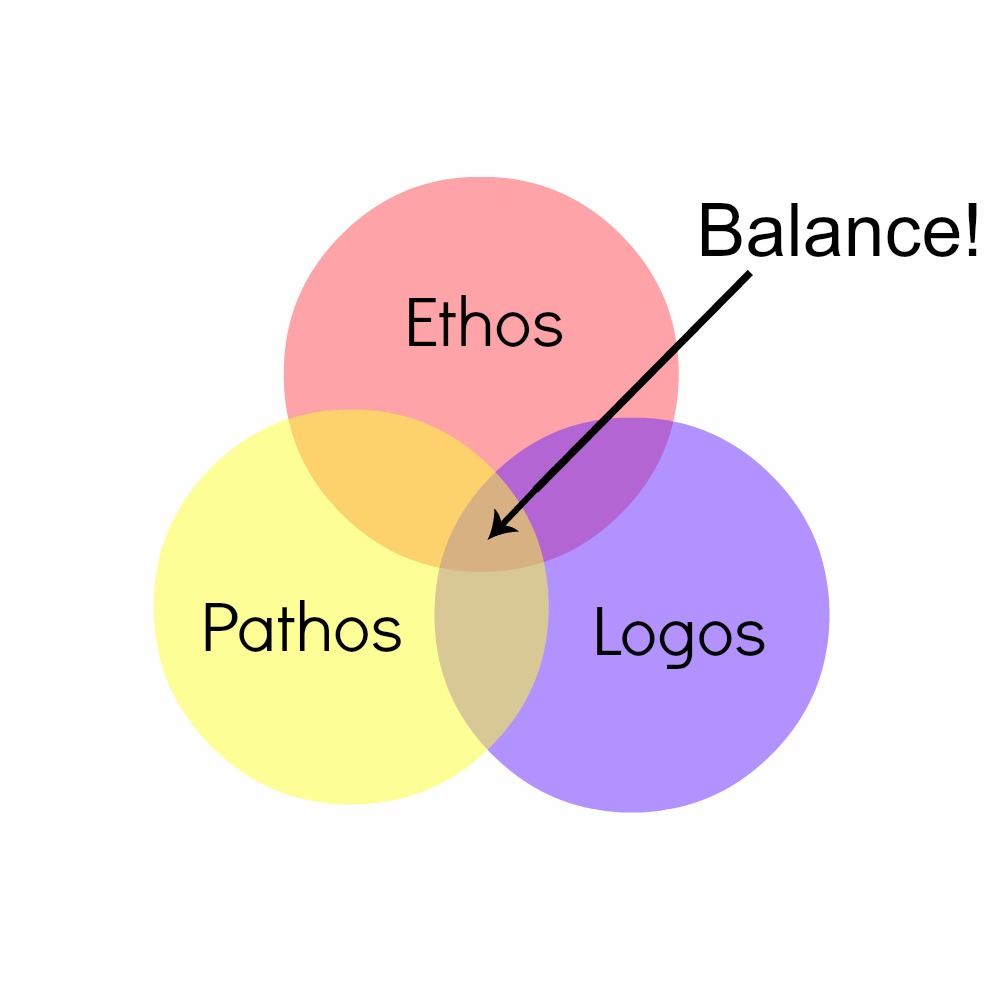
by Jace Vernon | May 13, 2013 | Animated Whiteboard Videos, Creative Marketing, Marketing, Memory, Video Marketing, video online marketing, Video Scribing, Whiteboard animation, Whiteboard Video, Writing a Script, Ydraw
Writing whiteboard video scripts using Ethos, Pathos and Logos
When you sit down to begin writing the script for your online marketing video, you want to keep three little words in your mind: Ethos, Pathos, and Logos. These are the modes of persuasion. When trying to persuade somebody to do something – say, buy your product – you need to make sure we sound credible, appeal to the emotions, and prove certain truths about our company and product. If you’re a good marketer, you’ve obviously lived by the E.P.L mantra, but with whiteboard animation things can be a little different. Here’s some information on how using ethos, pathos and logos in a whiteboard video can work for you:
Ethos is the integrity of the presenter. It is how qualified the presenter appears to be to the audience. When writing a script for a marketing video such as a whiteboard animation video, you have to rely more heavily on everything other than body language or presence to get your message across. If you’re trying to sell something, have an image of the CEO telling viewers all about the company. Write a part with some testimonials. Whoever your main character is, make sure they look the part, and that the audience can tell they are a notable figure and have vested interest in the company or product.
Pathos is triggering emotions. In your whiteboard video, throw in a metaphor or simile, or deliver your message powerfully and passionately. Make the audience feel something, whether it is sadness for the characters who don’t have your product, joy for the characters who do, or excitement at the prospect of purchasing your product themselves. Pathos may also be used to provoke fear in order to sway viewers – but it is always better for whiteboard videos to focus on the fun, positive aspects. Try to play on viewers’ hopes and dreams by describing how their life could be when they follow the call to action.

Logos is the logical appeal used when describing facts and figures that support your cause. Logos and ethos are sort of related – in the sense that using logos can strengthen your ethos by making you look even more knowledgeable on the subject. However, be tasteful in your use of logos when making a whiteboard video – you want your audience to retain information with ease. If you use charts and figures, make sure to incorporate it into the theme of the video, and don’t throw so many statistics at them that they can’t remember why they clicked play.
These are what you need to keep in mind when writing. Ethos, Pathos, and Logos. Thanks Aristotle.

by Jace Vernon | Mar 27, 2013 | Video Marketing, video online marketing
The demographic reach of online video – who views most? / part II
…And we’re back. Today’s segment is Part II of the Demographic Reach of Video Marketing series.* Sit tight, all you video marketing enthusiasts, as we dispel some rumors about who and how many people are online streaming video:
Last week I suggested that the bulk of online video viewers are in the 18-35 age range. Upon further study I discovered this is mostly true. But there were a few categories of consumers that are often overlooked, and I found some surprising statistics about them:
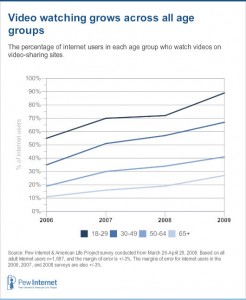
[image from pewinternet.org]
Though young adults are well aware they can catch up on their favorite media with the click of a mouse or swipe of a finger, older demographics are slowly realizing they can watch their favorite clips of Coach for free on YouTube or entire episodes for a mere $8/month on Netflix; saving them thousands per year on their satellite subscriptions (you’ve heard nothing good is ever on TV these days anyway). Though their numbers may seem significantly smaller than their young adult counterparts, the adult and elderly demographics are spending more time online each year (41% compared to 90%, respectively).
You may also be surprised to hear that teenagers do not make up the bulk of online viewers. Yes, that does mean they’re not the ones watching all those cat videos. That’s us.
Teenagers make up only 5.6% of online viewers, however once they pass into the 18-35 threshold, they tend spend about 14% more time online.
Take a look at this graph created by ReelSEO:
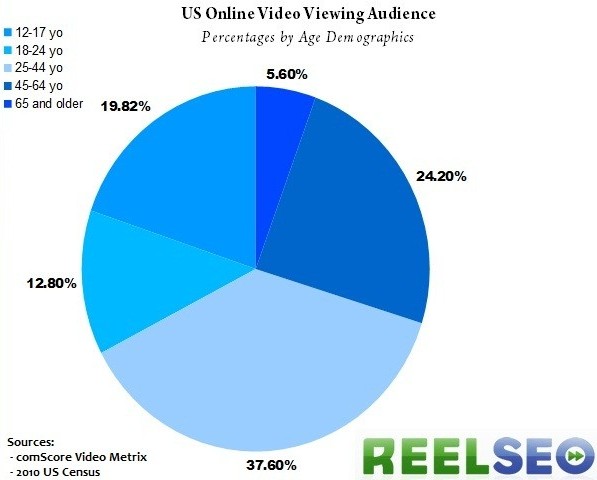
According to ReelSEO, the largest demographic of online video viewers are in the 25-44 age range. This holds pretty true with what I suggested in last week’s article. However, the second largest group is not the age group younger, but older. Consumers aged 45-64 spend almost double the amount of time online as young adults. Which can only mean this:
Though they’re still slow on the road, the adults and the elderly have the money and the fastest internet speeds – and that deserves some attention.
+Jessica Anderson can’t wait to spend more time browsing online and dropping dough.
*series is a somewhat loosely used term here.

by Jace Vernon | Mar 22, 2013 | video, Video Marketing, video online marketing
Demographic reach of video – almost everyone views, but who views most?
Video marketing is great for everyone, but it is especially appealing to the young adult (under 35) demographic. Roughly 70% of consumers aged 18-30 are regular online video viewers. That’s a large percentage, and here are three reasons why this stat is totes good news for your business, brah:
1. Fantastic Plastic
Young people usually don’t have a lot of money, but they also don’t have anyone to tell them how or how not to spend it – and even if they did, they don’t really have to listen, do they? This means you’ve got a better shot at coaxing them to give you their money than you do an elderly senior who has scrimped and saved his or her whole life just for a comfortable retirement.
2. Full-On Addiction
While some seniors are having conniptions over how to work them darn smart telephones and computer boxes, young people have them permanently embedded into their palms. Young adults are so passionate about technology that they’ll wear it as eyeglasses – they can watch your marketing video as they walk right into a streetlamp pole.
3. In a Way, Ingenuitive
Young people are lazy (wait a minute now, hold your britches); they’re also smart. If, while browsing YouTube at the office, they find there is a product out there that will make their lives easier – they’ll usually buy it – freeing up more time to watch more video work on meeting that deadline.
This post may over-glamorize the gullibility of young adults and their eagerness to spend – but the main points are these: this demographic watches video, and they watch it often. If they have money, they’re usually looking to spend it. They’re basically carrying around a mobile advertising device everywhere they go. If you don’t have a marketing video yet – dude, what’s your deal? YOLO (your onlookers live online)!
* * * * * * * * * * * * * * * * * * * * * * * * * * * * *
Hold on… don’t go dismissing the middle-aged and the old-timers, there is research that suggests they make up a pretty significant chunk in Youtube views, too. Stay tuned – more on that subject to come.
+Jessica Anderson would like you to know she does not use the terms “totes,” “brah,” and “yolo” on a regular basis.
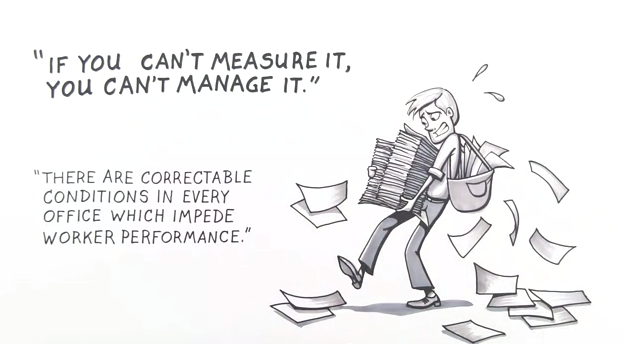
by Ydraw | May 10, 2012 | animated explainer video
Animated explainer videos are essential for improving landing pages
Ydraw believes this, and wants to share with others the benefits of using animated explainer videos in landing pages.
Animated explainer videos improve landing pages in many areas, and here are four that are defined in detail.
Expanding Technology
Because technology is continually expanding and businesses are always looking for ways to increase traffic and improve their conversion rates, learning more about the current trends in advertising and promotion are very important to businesses. Just because a website was fabulously popular a year ago doesn’t necessarily mean that it is still making conversions at the same high rate. Many people are finding that using an animated explainer video is an excellent way to improve conversion rates.
Interest Level
One reason for this is the interest level that videos have over simply having text to read. In today’s world, interest must be grabbed quickly and is easily lost. Being able to grab and hold attention is the key to getting conversions. Animated Explainer Videos move quickly and constantly as the scribing follows along with the voice to keep a person’s attention much longer than just text or an audio clip. The clever pictures that are drawn and the injection of appropriate text keep the viewer interested and guessing what will come next. This keeps the attention focused, which is what most businesses want to happen on their landing pages.
Increased Conversion Rate
Statistics seem to uphold the notion that video keeps attention longer than just text does, as companies have reported increased conversion rates when using video on landing pages. When the overall marketing strategy has a landing page video to focus on, then email, social media, PPC advertising, SEO, and all promotions can drive prospective customers to the landing page where the video provokes a higher conversion rate.
Focal Point
Whether the animated explainer video is designed to instruct for the purpose of training, describes the company and what it offers, explains a service provided by the company, or demonstrates a product, its fast-moving animation keeps the customer’s attention riveted. The combination of visual and audio input provides more information to the customer who is then more willing to make a purchase or at least take the next step to learn more.
a link Webmaster Resources
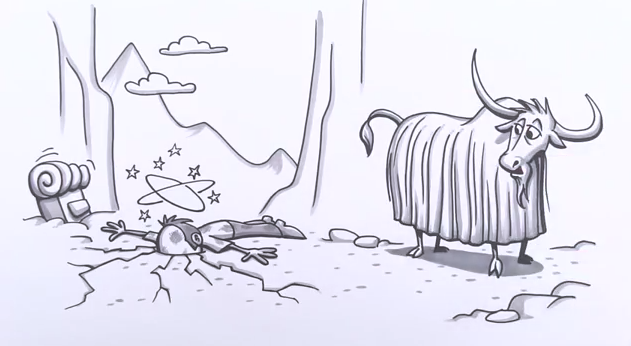
by Ydraw | May 10, 2012 | Video Marketing
How to Market Your New Animation Video
Ok so you have your new video or you have a video and you need to know how to get it out to the markets. Well, you’re not alone. Video Marketing is not an easy task, but it is critical to your success.
I am going to try and make this article as simple as possible and give you steps to get your video out there. You can always go more complicated, but that topic is for another day. Lets start with the reason why!
TO GET LEADS, CLIENTS, AND BUSINESS!
Both B2C and B2B marketers are confused and searching to discover the new ways to convert visitors to prospects and prospects to customers, and video is a key component.
Why Video?
- Online video adoption soars
- 50% of Internet traffic this year will be video
- 4 billion daily views on YouTube, 2.5 days worth of video uploaded every minute
- 75% of C-Suite executives surveyed said they watch work-related online video on business-related websites at least weekly
- 183 million U.S. Internet users watched online video content in December 2011 for an average of 20 hours per viewer
- On Google, an indexed video stands a 50X greater chance of ranking on the first results page than any textual page
- 24 Million U.S. smartphone users are currently watching online videos on their mobile device at least monthly
How to Marketing Your Video
1. Put your Video on Youtube, Vimeo and the other video sites out there. There are about 100, so take some of the top ones. Here is a simple list:
- YouTube
- Vimeo
- Dailymotion
- Veoh
- Google Video
- Metacafe
Make sure your keywords and description are filled out correctly and match with your target keywords.
2. Create a press release for you video. You can pay for a press release or use a free one.
3. Create a blog post around your video.
4. Create a linking wheel around your blog post.
5. Post video to Facebook, Twitter, and Linkedin.
6. Shoot out an email to your customers, future customers, friends, and family.
There you have it. Simple Right?







